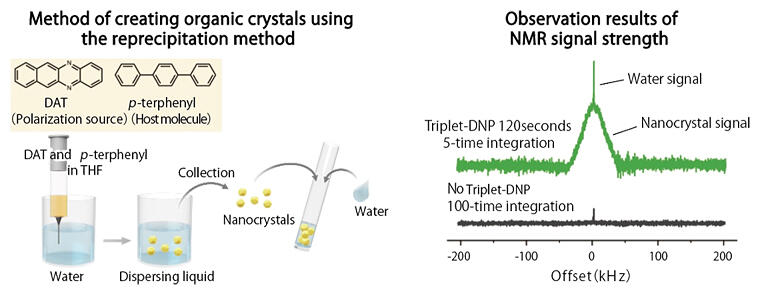Atoms and molecules have a magnetic property called nuclear spin. Methods harnessing this attribute to obtain information about molecules include Nuclear Magnetic Resonance (NMR) and Magnetic Resonance Imaging (MRI). MRI uses the signals of water molecules in the body, but one difficulty it has faced is that extremely little nuclear spin can be detected at room temperature - only 0.001% (1 in 100,000), making these signals weak. One solution is to use dynamic nuclear polarization, which increases the detectable nuclear spin, but it requires ultra-low temperature measurement (below −150℃) or the addition of radical molecules, which adversely affects measurements.
A research group led by Associate Professor Nobuhiro Yanai of the Department of Applied Chemistry, Graduate School of Engineering, Kyushu University, has developed a new method - hyperpolarization relays - which transfers nuclear polarization with the nuclear spin of organic crystals in alignment to water molecules. This is the first time that nuclear polarization of water has been achieved at room temperature. It is believed that as the crystal size becomes smaller the surface area per unit volume increases, leading to a larger area that can be used in nuclear polarization relays in contact with water molecules, increasing the efficiency of polarization transfer. This research has used the reprecipitation method to create and analyze organic nanocrystals of varying sizes, in doing so demonstrating the relationship between crystal size and efficiency of nuclear polarization relay to water molecules.
Although there have been examples of crystal polarization in the past, transfer of polarization to a liquid had never before been achieved. Associate Professor Yanai's team has succeeded in making the impossible possible, as if they had turned black into white or night into day. Looking ahead, their approach is expected to attract attention by contributing to improved sensitivity of NMR and MRI to a wide range of biomolecules as well as being a new method of pharmaceutical screening and structural analysis of proteins in living cells.





